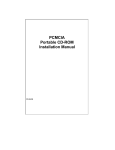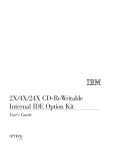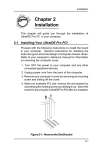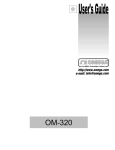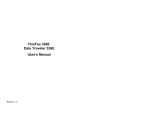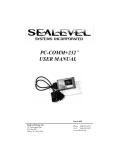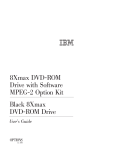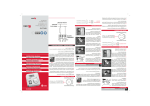Download User`s Manual
Transcript
User’s Manual FCC COMPLIANCE STATEMENTS This equipment has been tested and found to comply with the limits for a Class B digital device, pursuant to Part 15 of the FCC Rules. These limits are designed to provide reasonable protection against harmful interference in a residential installation. This equipment generates, uses and can radiate radio frequency energy and, if not installed and used in accordance with the instructions, may cause harmful interference to radio communications. However, there is no guarantee that interference will not occur in a particular installation. If this equipment does cause harmful interference to radio or television reception, which can be determined by turning the equipment off and on, the user is encouraged to try to correct the interference by one or more of the following measures: Reorient or relocate the receiving antenna. Increase the Distance between the equipment and receiver. Connect the equipment into an outlet on a circuit different from that to which the receiver is connected. Consult the dealer or an experienced radio/TV technician for help. CAUTION CHANGE OR MODIFICATIONS NOT EXPRESSLY APPROVED BY PARTY RESPONSIBLE FOR COMPLIANCE COULD VOID THE USER AUTHORITY TO OPERATE THE EQUIPMENT. TRADEMARKS PCMCIA are the trademarks of Personal Computer Memory Card International Association. MS-DOS, Windows, Windows 95/98/Me/2000/XP/NT and MSCDEX are trademarks of Microsoft Corporation. OS/2 WARP is a trademark of International Business Machines Corporation. *All of the third-party brands and names are the property of their respective owners. CONTENTS INTRODUCTION ........................................................................................................... 1 SYSTEM REQUIREMENTS .......................................................................................... 1 PART NAMES AND FUNCTIONS ............................................................................... 2 FRONT PANEL OF THE DVD-ROM DRIVE ........................................................ 2 REAR PANEL OF THE DVD-ROM DRIVE .......................................................... 3 HARDWARE INSTALLATION .................................................................................... 4 SOFTWARE INSTALLATION FOR WINDOWS 95/98 .............................................. 6 SOFTWARE INSTALLATION FOR WINDOWS Me ................................................. 9 SOFTWARE INSTALLATION FOR WINDOWS 2000 ............................................... 11 SOFTWARE INSTALLATION FOR WINDOWS XP ................................................. 14 SOFTWARE INSTALLATION FOR WINDOWS NT ................................................. 17 SOFTWARE INSTALLATION FOR DOS/WINDOWS 3.1 ........................................ 19 SOFTWARE INSTALLATION FOR OS/2 WARP ....................................................... 24 USING DVD-ROM WITH PCMCIA INTERFACE ...................................................... 27 INTRODUCTION The External DVD-ROM has the following features: ♦ It c can be easily connected to computer via PCMCIA interface, and can even be disconnected and re-connected while the computer is running. ♦ This drive can read all types of CD and DVD media including CD, CD-R, CD-RW and DVD disc. ♦ When working with DVD playing software, this drive can playback DVD title smoothly. This user’s manual is intended to describe how to install the external DVD-ROM on the computer. To use the DVD playing software, please refer to the ‘On-Line help’ in the playing software. SYSTEM REQUIREMENTS ♦ Notebook or desktop computer with PCMCIA 2.1 Type II or III socket. ♦ Windows 95/98/Me/2000 or Windows XP (The Hot Insert/Remove function is reachable with these OS). ♦ Windows NT, DOS/Windows 3.1 or OS/2 WARP (These OS don’t support Hot Insert/Remove function). -1- PART NAMES AND FUNCTIONS Your external DVD-ROM may differ slightly from the figures shown, however the controls will operate as described below. Front Panel Of The DVD-ROM Drive 1. Disc Ready/Read LED: This LED is used to indicate the disc access status. 2. Eject Button: Press this button to open the disc tray. To close the disc tray, gently push the front of the tray. 3. Emergency Eject: In case you cannot supply power to the drive but want to remove a disc from the tray, push a small rod (paperclip) about 5cm long, through the Emergency Eject hole to disengage the gears inside. Then pull the tray out manually. After removing the disc, gently push the tray back to its original position. This procedure is only to be used in the case of an emergency and is not meant for normal operation. -2- Rear Panel Of The DVD-ROM Drive 1. Power Jack (DC IN): Connect the AC adapter lead here. 2. Power Source Switch: PC: Means this DVD-ROM is powered by the PCMCIA socket of computer. DC: Means this DVD-ROM is powered by the AC adapter. Usually, when the external DVD-ROM get the power from the PCMCIA socket of computer, and it should work properly. But, with some models of computer, the supplied power from the PCMCIA socket is poor to drives the DVD-ROM drive. In this situation, an AC adapter is needed. If you experience this problem, please contact dealer for the AC adapter. 3. Interface Connector: Connect the PCMCIA interface cable here. 4. Power Button: Press this button to manually power on/off the drive. -3- HARDWARE INSTALLATION Note: ♦ If you want to use an AC adapter to powers the external DVD-ROM, please use the AC adapter provided by manufacturer, using an incorrect AC adapter could result in permanent and unpredictable damage to the drive. ♦ This external DVD-ROM supports Hot Insert/Remove function only under Windows 95/98/Me/2000/XP, with the other operating systems, please insert the PC Card of interface cable before power-on computer, and remove this card after power-off computer. 1. Insert the plug of the PCMCIA interface cable into the Interface Connector of drive. Press firmly until the interface connector is seated correctly. 2. Make sure the Power Source Switch is at the correct position. PC: get power from the PCMCIA socket of computer. DC: get power from the AC adapter. Note: If you are using an AC adapter to powers the external DVD-ROM, make sure the Power Source Switch is at the ‘DC’ position, then connect the AC adapter to the Power Jack (DC IN) of the drive, and attach the AC adapter to the outlet. 3. Place the DVD-ROM drive in the horizontal position. This drive is designed to operate only in the horizontal position. Operating the DVD-ROM drive in any abnormal position is not recommended. 4. You are now ready to install the device drivers, please follow the related software installation guide to install the device driver. -4- Get power from PCMCIA socket Switch to PC position Push Push Get power from AC adapter Switch to DC position Push Push -5- SOFTWARE INSTALLATION FOR WINDOWS 95/98 The following installation procedures are extracted from the Windows 98SE installation. The installation for Windows 95 is almost same. 1. Boot-up your computer into Windows 98, making sure the device driver for ‘PCMCIA Socket’ has been installed and is available. To check this, right-click ‘My Computer’, click ‘Properties’ and then ‘Device Manager’ to open the ‘Device Manager’ window. Refer to the figure shown alongside to see if the PCMCIA Controller is installed without error. 2. Ensure the PCMCIA interface cable and then the AC adapter connections (if you are using the AC adapter) are made as described in Hardware Installation. Slowly insert the PC Card of interface cable into the PCMCIA socket of computer and press firmly until the connector is seated (Please note that the PC Card is keyed to guide for proper insertion). 3. If this is the very first time you are connecting the drive to computer, the ‘Add New Hardware Wizard’ dialog box appears as shown. 4. Click Next, then select ‘Search for the best driver for your device’ box, and click Next. -6- 5. Select ‘Floppy disk drives’ box and insert the device driver diskette into floppy drive. Click Next. 6. Wait for few seconds, Windows will find a driver from the floppy diskette, make sure the file that Windows found is ‘A:\ PCMCDF.INF’. Click Next. 7. After the necessary files are copied into your internal hard disk, a screen will appear as the figure, click Finish. 8. Windows will then detect the DVD-ROM drive, you will find a new drive letter has been assigned for the drive in ‘My Computer’. -7- 9. If the external DVD-ROM doesn’t appear in ‘My Computer’ or doesn’t work properly, please go into ‘Device Manager’ to check whether the devices are installed as the table and figure. Installed Device Drivers Location PCMCIA CD-ROM/CD-RW/DVD-ROM (F2) Installed under ‘SCSI Controllers’. The real name of the DVD-ROM drive Installed under ‘CDROM’ (the name list in the figure may differ from your DVD-ROM drive). -8- SOFTWARE INSTALLATION FOR WINDOWS Me 1. Boot-up your computer into Windows Me, making sure the device driver for ‘PCMCIA Socket’ has been installed and is available. To check this, right-click ‘My Computer’, click ‘Properties’ and then ‘Device Manager’ to open the ‘Device Manager’ window. Refer to the figure shown alongside to see if the PCMCIA Controller is installed without error. 2. Ensure the PCMCIA interface cable and then the AC adapter connections (if you are using the AC adapter) are made as described in Hardware Installation. Slowly insert the PC Card of interface cable into the PCMCIA socket of computer and press firmly until the connector is seated (Please note that the PC Card is keyed to guide for proper insertion). 3. On the first screen, insert the device driver diskette into floppy drive, select ‘Automatic search for a better driver (Recommended)’, and then click Next. 4. Windows will find two driver files from the floppy diskette and list as the figure shown alongside. In fact, these two drivers are the same, choose any one and then click OK. -9- 5. Windows will install the driver from the diskette. After the necessary files are copied into your internal hard disk, a screen will appear as the figure, click Finish. 6. Windows will then detect the DVD-ROM drive, you will find a new drive letter has been assigned for the drive in ‘My Computer’. 7. If the external DVD-ROM doesn’t appear in ‘My Computer’ or doesn’t work properly, please go into ‘Device Manager’ to check whether the devices are installed as the table and figure. Installed Device Drivers Location PCMCIA CD-ROM/CD-RW/DVD-ROM (F2) Installed under ‘SCSI Controllers’. The real name of the DVD-ROM drive Installed under ‘CDROM’ (the name list in the figure may differ from your DVD-ROM drive). - 10 - SOFTWARE INSTALLATION FOR WINDOWS 2000 1. Boot-up your computer into Windows 2000, making sure the device driver for ‘PCMCIA Adapters’ has been installed and is available. To check this, right-click ‘My Computer’, click ‘Properties’ then ‘Hardware’ and then ‘Device Manager’ to open the ‘Device Manager’ window. Refer to the figure shown alongside to see if the PCMCIA Controller is installed without error. 2. Ensure the PCMCIA interface cable and then the AC adapter connections (if you are using the AC adapter) are made as described in Hardware Installation. Slowly insert the PC Card of interface cable into the PCMCIA socket of computer and press firmly until the connector is seated (Please note that the PC Card is keyed to guide for proper insertion). 3. Windows will find a new hardware named ‘PCMCIA PnPIDE’, and start up the ‘Found New Hardware Wizard’, click Next on the first screen. 4. On this screen, select ‘Search for a suitable driver for my device (Recommended)’, click Next. - 11 - 5. Insert the device driver diskette into floppy drive, only select ‘Specify a location’, leave the other check boxes be empty (don’t select them), and click Next. When the wizard asks for the path, type ‘A:\WIN2000’ in ‘Copy manufacturer’s files from’ location, click OK. 6. Wait for few seconds, Windows will find a driver from the floppy diskette, make sure the file that Windows found is ‘A:\Win2000\PCMCDF2K.INF’. Click Next. 7. Click Yes on the ‘Digital Signature Not Found’ screen. - 12 - 8. After the necessary files are copied into your internal hard disk, a screen will appear as the figure, click Finish. 9. Windows will then detect the DVD-ROM drive, you will find a new drive letter has been assigned for the drive in ‘My Computer’. 10. If the external DVD-ROM doesn’t appear in ‘My Computer’ or doesn’t work properly, please go into ‘Device Manager’ to check whether the devices are installed as the table and figure. Installed Device Drivers Location PCMCIA CD-ROM/CD-RW/DVD-ROM (F2) (Windows 2000) Installed under ‘IDE ATA/ATAPI Controllers’. The real name of the DVD-ROM drive Installed under ‘DVD/CD-ROM Drives’ (the name list in the figure may differ from your DVD-ROM drive). - 13 - SOFTWARE INSTALLATION FOR WINDOWS XP 1. Boot-up your computer into Windows XP, making sure the device driver for ‘PCMCIA Adapters’ has been installed and is available. To check this, right-click ‘My Computer’, click ‘Properties’ then ‘Hardware’ and then ‘Device Manager’ to open the ‘Device Manager’ window. Refer to the figure shown alongside to see if the PCMCIA Controller is installed without error. 2. Ensure the PCMCIA interface cable and then the AC adapter connections (if you are using the AC adapter) are made as described in Hardware Installation. Slowly insert the PC Card of interface cable into the PCMCIA socket of computer and press firmly until the connector is seated (Please note that the PC Card is keyed to guide for proper insertion). 3. Windows will find a new hardware named ‘PCMCIA PnPIDE’, and start up the ‘Found New Hardware Wizard’. On the first screen, select ‘Install from a list or specific location (Advanced)’, and then click Next. - 14 - 4. On this screen, select ‘Search for the best driver in these locations’ and ‘Include this location in the search:’, type ‘A:\WINXP’ in the box. Don’t select ‘Search removable media’. Now, insert the driver diskette into floppy drive, and then click Next to continue. 5. Windows will find driver from the diskette and install it automatically. 6. After the necessary files are copied into your internal hard disk, a screen will appear as the figure, click Finish. 7. Windows will then detect the DVD-ROM drive, you will find a new drive letter has been assigned for the drive in ‘My Computer’. - 15 - 8. If the external DVD-ROM doesn’t appear in ‘My Computer’ or doesn’t work properly, please go into ‘Device Manager’ to check whether the devices are installed as the table and figure. Installed Device Drivers Location PCMCIA IDE Card (F2) (WINXP) Installed under ‘SCSI and RAID Controllers’. The real name of the DVD-ROM drive Installed under ‘DVD/CD-ROM Drives’ (the name list in the figure may differ from your DVD-ROM drive). - 16 - SOFTWARE INSTALLATION FOR WINDOWS NT Note: ♦ Make sure the Windows NT system is version 3.51 or higher. ♦ Since Windows NT does not support ‘Hot Insert/Remove’ feature, this external DVD-ROM should be connected to computer prior to starting Windows NT. Likewise, do not remove this drive before you shut down the computer. ♦ In Windows NT, the I/O and IRQ settings of PCMCIA IDE device cannot be changed. Therefore, if the setting of this DVD-ROM conflicts with other device, change the I/O or IRQ of other device to avoid conflicts. ♦ We recommend you install a Card Service program, e.g. SystemSoft’s CardWizard for Windows NT. This kind of program will help Windows NT to assign resource for PCMCIA device properly, and reduce the conflict situation. 1. Do not connect the external DVD-ROM to computer, just power-on the computer and boot into Windows. 2. Click on Start Ö Settings Ö Control Panel Ö SCSI Adapter. The ‘SCSI Adapter’ dialog box appears. 3. Click Drivers tab, and then click Add button. 4. Click Have Disk button to continue. Windows NT will then prompt you to insert the manufacturer’s driver diskette. Insert the device driver diskette into floppy drive. Specify the directory as A:\WINNT (or B:\WINNT whichever contains the diskette) and click OK. - 17 - 5. Select ‘PCMCIA CD-ROM/ CD-RW/DVD-ROM/HDD’ and then click OK. 6. Follow the on-screen instruction to continue. After the installation is complete, Windows will prompt you to restart to activate the new device driver. Restart and power-off the computer. 7. Ensure the PCMCIA interface cable and then the AC adapter connections (if you are using the AC adapter) are made as described in Hardware Installation. Slowly insert the PC Card of interface cable into the PCMCIA socket of computer and press firmly until the connector is seated (Please note that the PC Card is keyed to guide for proper insertion). 8. Power-on the computer, after boot into Windows, the external DVD-ROM will be assigned a drive letter in ‘My Computer’, the drive is ready for use. - 18 - SOFTWARE INSTALLATION FOR DOS/WINDOWS 3.1 Automatic Installation Follow the instructions below to proceed with automatic installation. 1. Insert the device driver diskette into a floppy disk drive on your computer. 2. Change the working directory to the floppy drive containing the device driver diskette by typing A: then press ENTER. 3. At the DOS prompt (A:\>), type INSTALL followed by the ENTER key. 4. Press ENTER or click OK button to continue. The screen will display as the following: 1) Directory to install driver: Type the directory that you want the driver files are copied to, and then press the TAB key to forward to the next field. 2) DOS directory: To specify the directory containing the file MSCDEX.EXE. Type the directory, then press the TAB key to forward to the next field. 3) Set I/O port to: The default setting is 320-32F. 5. After completing the selection, press TAB key to the Install button, and press ENTER to continue. 6. The rest of the installation should proceed automatically, the CONFIG.SYS and AUTOEXEC.BAT files on your computer will be updated automatically. - 19 - 7. Reboot your computer and the DVD-ROM drive will be defined as the next available drive letter. For example, if the last hard drive of the computer is drive C, the DVD-ROM drive will be assigned to drive D. Manual Installation You may also manually install the external DVD-ROM device driver if the default setting conflicts with your system. Perform the following procedures to complete the manual installation. Note: The filename of the DOS device driver is different with the different version of driver package, it could be ARICDF.EXE or NVICDF.EXE. However, you can find this driver in the root folder of the diskette, the filename will be present as xxxCDF.EXE. The following example is assumed the filename is ARICDF.EXE, replace the filename if you get the different driver file. 1. Copy the file ARICDF.EXE from the device driver diskette to your hard disk. 2. Add the following line to the TOP of your CONFIG.SYS file. If there is already a LASTDRIVE line with a letter other than Z, change it to Z. LASTDRIVE=Z 3. Add the following line to the BOTTOM of your CONFIG.SYS file: DEVICE=drive:\path\ARICDF.EXE /P:320 /D:MSCD001 Where drive:\path specifies the directory containing ARICDF.EXE. Note: If your CONFIG.SYS file is already loaded with PCMCIA software, such as Cardsoft of SystemSoft or Cardtalk of Databook, it is necessary to add the above line after the PCMCIA software. Otherwise, the PCMCIA interface card will not be initialized properly. ARICDF.EXE is the device driver for the PCMCIA DVD-ROM. The parameters of ARICDF.EXE are described below: - 20 - /P is used to set the I/O ports, and the valid numbers are 320, 340, and 360, and the default setting is /P:320. /D is used to set the device name. It can be any name up to 8 characters. This name must be the same as the name specified in the MSCDEX.EXE option /D:name in the next step. 4. Add the following line at the TOP of your AUTOEXEC.BAT: drive:\path\MSCDEX.EXE /D:MSCD001 /M:4 Where drive:\path specifies the DOS directory or the directory containing the file MSCDEX.EXE. Note: If your AUTOEXEC.BAT file loads a menu program such as DOSSHELL or Windows, you have to add the above line in front of your menu program. Otherwise, MSCDEX will not have a chance to load before your menu program begins. The example above shows the default setting. The /D: switch indicates the device name. It MUST be the same name specified by the /D: switch of ARICDF.EXE in your CONFIG.SYS file. The /M: switch indicates how much memory to allocate for caching information on the DVD-ROM. The default /M:4 caches 8KB. For more information about the switches of MSCDEX, please type ‘help MSCDEX’ at the DOS prompt. 5. Now, reboot your computer to activate the external DVD-ROM drive. Explanation Of The Error Messages This section explains the most common error messages that DOS/Windows 3.1 users may encounter. After rebooting your computer, the following messages will be displayed on your screen, which are generated by ARICDF.EXE and MSCDEX.EXE. Configure card to: I/O Port: 320-32F Device Name: MSCD001 - 21 - PCMCIA CD-ROM card is present in socket 1 : Drive D: = Driver MSCD001 unit 0 If any errors occur or the external DVD-ROM does not work, you should reboot your computer again. When the system displays ‘Starting MS-DOS...’, press the F8 key to execute CONFIG.SYS and AUTOEXEC.BAT step by step. You can consistently press the Y key to see each command’s message. Error Messages Generated By ARICDF.EXE: ♦ Error: PCMCIA CD-ROM/DVD-ROM card is not present! If the above message appears, it means ARICDF can’t find the PCMCIA interface card in your PCMCIA sockets. Make sure the PCMCIA interface card is inserted firmly. ♦ Error: Illegal arguments! The above error message means that there are invalid arguments in the ARICDF line of CONFIG.SYS. Please refer to the section titled ‘Manual Installation’ for the usage of ARICDF.EXE. ♦ Error: I/O port must be specified! The above message means you have not specified the I/O port argument in the ARICDF line of CONFIG.SYS. ♦ Error: Illegal I/O port! The above message means invalid I/O ports in the ARICDF line of CONFIG.SYS have been selected. The legal I/O port numbers are: 320, 340, and 360. ♦ Error: There is no available 4K memory for mapping! The above message means ARICDF can’t find available 4K memory between C000:0 to EFFF:0. This error can be corrected by changing the EMM386 line of CONFIG.SYS to exclude at least 4K memory for mapping. For example, DEVICE=C:\DOS\EMM386.EXE ... X=D000-D3FF - 22 - ♦ Error: The INTEL 82365SL PCMCIA controller is not detected in your system. You should contact your dealer to get PCMCIA support software. The above message means the PCMCIA controller of your computer is not INTEL 82365SL compatible. In this case, you should install PCMCIA support software that should be supplied by the notebook manufacturer. ♦ CD-ROM or DVD-ROM Drive is not found! The above message means ARICDF.EXE can’t find the external DVD-ROM drive. Please make sure the DVD-ROM drive is properly connected to the PCMCIA interface card cable, and the AC adapter is connected properly. Error Messages Generated By MSCDEX.EXE: ♦ Device driver not found: 'MSCD001' This means that ARICDF.EXE is not installed properly or you have entered a different /D: switch in the MSCDEX line of AUTOEXEC.BAT. The device name specified by the /D: switch must be the same as the /D: switch in the ARICDF.EXE line of CONFIG.SYS. - 23 - SOFTWARE INSTALLATION FOR OS/2 WARP Before installing the external DVD-ROM device driver for OS/2 WARP, make sure your computer is PCMCIA supported. If you are not sure about this, please refer to the last part of this chapter for ‘Adding PCMCIA Support’. Automatic Installation 1. Insert the device driver diskette into floppy drive on your computer. 2. Open ‘OS/2 WARP’, and then open ‘Drives’. 3. Select Drive A or B depending on which floppy drive contains the device driver diskette. 4. Open ‘OS2WARP’ folder. Then double-click on ‘INSTALL2.EXE’. 5. A dialog box will be displayed for you to specify the OS/2 directory, the I/O address for the PCMCIA DVD-ROM and the IRQ number. After specifying the OS/2 directory, press TAB to set the I/O port and then the IRQ. The default setting of the I/O ports is 320-32F, and the default IRQ is 11. After completing the selection, press TAB to the Install button and press ENTER to continue. 6. The rest of the installation will proceed automatically. At the end, the on-screen instruction will prompt you to restart your computer to activate the external drive for OS/2 Warp. - 24 - Manual Installation You may also manually install the external DVD-ROM OS/2 device driver if the default setting conflicts with your system. Perform the following procedures to complete the manual installation. 1. Copy the ARICDF2.FLT file from A:\OS2WARP to the BOOT subdirectory of the OS/2 directory (for example: C:\OS2\BOOT.) 2. Add the following line to the BOTTOM of your CONFIG.SYS file: BASEDEV=ARICDF2.FLT /P:320 /I:11 The parameters of ARICDF2.FLT are described below: /P is used to set the I/O ports. The valid ports are 320, 340, and 360, and the default setting is /P:320. /I is used to set the IRQ number, the valid IRQs are 3, 4, 5, 7, 9, 10, 11, 12 and 15, and the default setting is /I:11. /V verbose mode, displays the initialization message. The default is quiet mode. 3. Meanwhile, check if the following lines exist in CONFIG.SYS, if not, add the following lines: DEVICE=C:\OS2\BOOT\OS2CDROM.DMD /Q IFS=C:\OS2\BOOT\CDFS.IFS /Q DEVICE=C:\OS2\MDOS\VCDROM.SYS Adding PCMCIA Support PCMCIA Support can be automatically installed during OS/2 installation or it can be installed through Selective Install after OS/2 installation. To check or install PCMCIA support, perform the following steps: 1. Open OS/2 System Ö Open System Setup Ö Open Selective Install. - 25 - 2. Check if PCMCIA Support has been installed in the System Configuration window, if yes, you may exit now, otherwise, perform the following steps to continue. 3. Select the check box to the left of PCMCIA Support to display the Select PCMCIA system window. 4. Select the appropriate system (this should either be a direct match with your target install system or a known compatible system). 5. Select OK Ö Select Install, then, follow the on-screen instructions to finish the installation - 26 - USING DVD-ROM WITH PCMCIA INTERFACE To Connect The PCMCIA DVD-ROM To Your Computer ♦ Windows 95/98/Me/2000, and WindowsXP: 1. Boot into the Windows system. 2. Insert the plug of the PCMCIA interface cable into the Interface Connector of drive. 3. Make sure the Power Source Switch is at the correct position: PC: get power from the PCMCIA socket of computer. DC: get power from the AC adapter. 4. If you are using the AC adapter, connect the AC adapter lead to the Power Jack (DC IN) at the rear panel of the drive. And then attach the AC adapter to the AC power outlet. 5. Slowly insert the PC Card of interface cable into the PCMCIA socket of computer and press firmly until the connector is seated. Your PCMCIA DVD-ROM is now ready for use in few seconds. ♦ Windows NT, DOS/Windows 3.1 and OS2 WARP: 1. Power-off the computer. 2. Insert the plug of the PCMCIA interface cable into the Interface Connector of drive. 3. Make sure the Power Source Switch is at the correct position: PC: get power from the PCMCIA socket of computer. DC: get power from the AC adapter. 4. If you are using the AC adapter, connect the AC adapter lead to the Power Jack (DC IN) at the rear panel of the drive. And then attach the AC adapter to the AC power outlet. 5. Slowly insert the PC Card of interface cable into the PCMCIA socket of computer and press firmly until the connector is seated. 6. Power-on computer, the PCMCIA DVD-ROM will ready for use after boot into the operating system. - 27 - To Disconnect The PCMCIA DVD-ROM From Your Computer ♦ Windows 95/98, and Windows Me: 1. Click on the icon (or ) on system tray and a dialog box appears beside this icon. 2. Click ‘Stop PCMCIA CD-ROM/CD-RW/DVD-ROM (F2)’ in the dialog box. 3. Wait for few seconds until the system prompts ‘The PCMCIA CD-ROM/CD-RW/DVD-ROM (F2) can now be safely removed from the system’. Click OK, and then remove the PC Card of the cable from computer. ♦ Windows 2000: 1. Click on the icon on system tray and a dialog box appears beside this icon. 2. Click ‘Stop PCMCIA CD-ROM/CD-RW/DVD-ROM (F2) (Windows 2000)’ in the dialog box. 3. Wait for few seconds until the system prompts ‘The PCMCIA CD-ROM/CD-RW/DVD-ROM (F2) (Windows 2000) can now be safely removed from the system’. Click OK, and then remove the PC Card of the cable from computer. ♦ Windows XP: 1. Click on the icon on system tray and a dialog box appears beside this icon. 2. Click ‘Safely remove PCMCIA IDE Card (F2) (WINXP)’ in the dialog box. 3. Wait for few seconds until system prompts ‘The PCMCIA IDE Card (F2) (WINXP) can now be safely removed from the system’, and then remove the PC Card of the cable from computer. ♦ Windows NT, DOS/Windows 3.1 and OS2 WARP: 1. Power-off the computer. 2. Remove the PC Card of the cable from computer. - 28 - P/N: 7450441-00 Printed in Taiwan








































